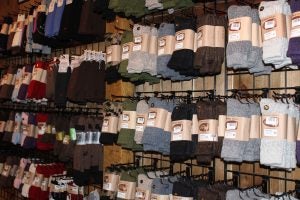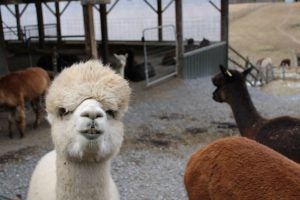Alpacas are cute, wooly, and funky looking farm animals that are often overlooked when many people think about farming and agriculture. Their long neck and little underbite may make them look pretty silly, but they shouldn’t be underestimated. Alpacas are livestock animals who contribute to agriculture all over the world.
Mark and Sharon Gilbride of Bloomfield, New York, realized how valuable alpacas are a long time ago. Their farm, Lazy Acre Alpacas, is home to 55 alpacas, all who are shorn once a year for wool production. The couple also offer tours to the public to see how alpacas contribute to the economy.
Alpacas are native to the mountainous regions of Chile, Peru, and Bolivia. Perhaps the most interesting thing about the alpaca is that they are comfortable in most any climate. Alpaca wool is a unique wool that is able to keep the animals cool in the heat, dry in the humidity, and warm in sub-zero temperatures.
Being comfortable in any climate is exactly what alpacas are able to offer us.
One stop in the tour of Lazy Acre Alpacas is the shearing barn. The Gilbrides offer samples of wool for everyone to touch, and they explain how the wool works its magic.
Alpaca wool is hollow, each hair looking like a string of sausages full of air. These air pockets absorb water and wick it away, which means that clothing made with alpaca wool is able to wick away sweat or keep you dry in wet conditions. In cold conditions, your body heat warms the air pockets, which in turn insulate you during even the coldest of temperatures.
Oftentimes alpaca wool products are not made up of only alpaca wool. The wool is blended with other materials such as bamboo, Spandex, linen, or even silk. Sharon says that sometimes customers in her alpaca products shop are turned off by the products not being made totally of alpaca. Sometimes people think that blending the wool with other materials is a way to make the product cheaper, but Sharon says it’s completely the opposite.

Sharon puts a lot of effort into educating people on the reasons for and benefits of blending alpaca wool with other materials. Alpaca wool, much like sheep wool, stretches over time. Nobody likes droopy socks or stretched out sweaters, so adding in other stretchy materials to the wool means that clothes can be worn for a much longer time without fear of stretching out. A popular blended product is alpaca wool running socks. The wool is blended with Merino wool, which is very good at wicking away odors.
Lazy Acre Alpacas live their lives out on the farm, producing only wool and the occasional cria (which is a juvenile alpaca). These alpacas are not raised for their meat, but alpaca meat is a delicacy in the United States.
Alpaca meat is described as having a mildly sweet taste, which is similar to veal. Alpacas generally have very little body fat, and they soak up the flavors of what they are cooked with. The meat is higher in protein, and lower in fat and cholesterol compared with beef, chicken, and salmon. Mark Gilbride explained that in Peru, people eat alpacas similarly to how we eat beef in the United States. Alpacas are popular dual purpose animals in South America.

Alpacas are not nearly as popular in the United States as they are in South America simply because they haven’t been around too long — they have only been in the U.S. since the 1980s. Since then most of the alpaca farms have sprung up on the West coast: Colorado, California, Oregon, and Washington being the states most populated with alpacas.
There are alpaca farmers like the Gilbrides all over the country who want to show us how alpacas are making an impact on American agriculture. They create a unique and useful product for people all over the world.
Elizabeth Maslyn is a Cornell University student pursuing a career in the dairy industry. Her passion for agriculture has driven her desire to learn more, and let the voices of our farmers be heard.



